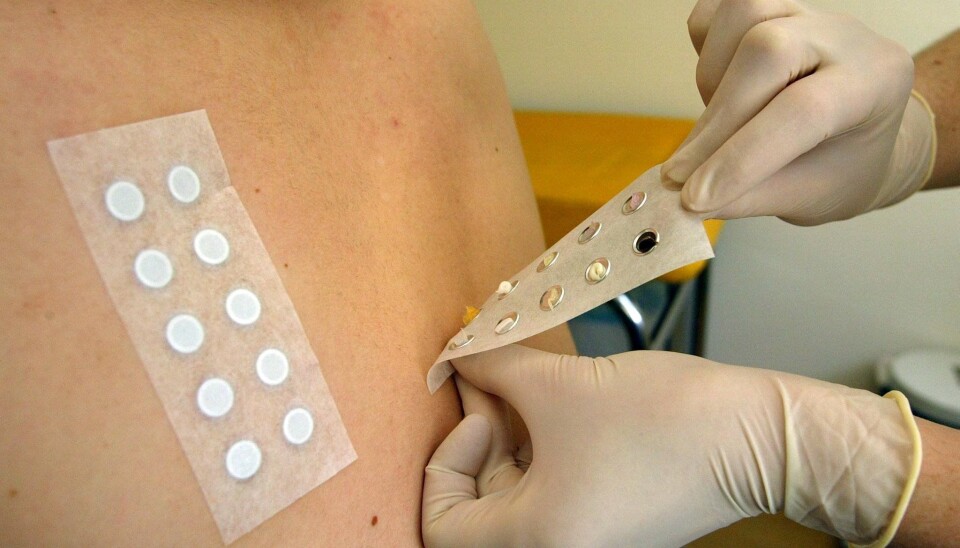An article from University of Oslo

Learning about allergies from skin disease
A rare skin disease that gives fish scale-like skin is providing a new understanding of the role skin plays in the development of allergies.
Denne artikkelen er over ti år gammel og kan inneholde utdatert informasjon.
Ichthyosis Prematurity Syndrome, abbreviated IPS, is a skin disease that occurs almost exclusively in Norway.
IPS is a type of ichthyosis, which is a skin disease causing patients to develop thick, dry skin that when touched may feel scaly. It is an inherited, often congenital disease, caused by a genetic defect and varies in severity.
"In addition, all sufferers are born prematurely, although we do not know the reason for this," explains Professor Frode Jahnsen, of the Centre for Immune Regulation at the University of Oslo.
Most patients come from the Trøndelag region in Mid-Norway. The inherited genetic defect has been handed down, and is the reason its prevalence is geographically limited. To date, scientists have identified 23 people affected by IPS.
Fat metabolism a determining factor
The Centre for Immune Regulation is trying to find the cause of IPS. And they have come up with meaningful results.
In collaboration with scientists in France and Sweden, Jahnsen and his associates have found defects in a protein that carries fatty acids in the skin. This defect leads to irregularities in the composition of fatty substances in the epidermis.
"Our contribution is that we have discovered a new disease with a new genetic defect which affects the metabolism of fat, and this is a disease that no one else has seen before," he says.
Common gene mutation
It all started with Dr. Tobias Gedde-Dahl about 30 years ago. Gedde-Dahl was a geneticist and therefore keenly interested in hereditary diseases.
He was particularly interested in ichthyosis. That's how he discovered some patients that he had not managed to place in a particular disease group. The symptoms these patients exhibited did not match any known disease.
Gedde-Dahl found more and more patients with the same characteristic and unexplained symptoms, and the odd thing was that all came from Trøndelag.
Samples of these patients were sent to Germany, where ultra-structural examinations of the skin were performed. It was found that the patients who were clinically similar to each other had the same genetic defect. All of the patients were born prematurely, and all had ichthyosis.
Today, Jahnsen heads the work here in Norway, while Denis Khnykin performs practical research work in the United States.
"Khnykin is the hands on person in this project," says Jahnsen.
The many and various specialists involved in the work are characteristic of this project. The fact that dermatologists, obstetricians, basic scientists, experts on fatty substances and scientists working with animal models are all helping, demonstrates the complex and, to some extent, unclarified pathological picture.
The skin's role in the development of allergies
The Norwegian IPS patients have been carefully monitored, and have shown themselves to be extremely allergic.
The researchers found significantly elevated levels of a particular type of white blood cell called eosinophils in all patients. This was a very peculiar finding, because few diseases are associated with this feature. In addition, they had elevated levels of immunoglobulin E. Both of these things are associated with allergies.
"Some patients have sky-high immunoglobulin values, which indicates strong allergies. They suffer from asthma, hay fever, food allergies and skin allergies. The question is why are they are so allergic," says Jahnsen.
It seems that the skin plays a far more important role in the development of allergies than scientists previously believed. The skin barrier plays an important protective function: it both prevents water loss and also ensures that things from the outside do not get into the skin.
Ichthyosis patients have thinner skin barriers. This means that they have excessive water loss and become dehydrated, while at the same time unwanted particles can penetrate the skin.
People with childhood eczema are more likely to develop allergies later in life. Combined with the importance of fat metabolism in the skin, this indicates that if the skin is not perfect, the risk of developing allergies increases substantially.
Animal models
In hereditary disease research scientists focus on identifying the genes that have something wrong with them.
"The first time we successfully identified the genetic defect was two years ago," explains Jahnsen.
To understand the origin and development of hereditary diseases, scientists must use animal models. When the genetic defect is identified, they can create mice that either lack the specific gene or are injected with the gene. This makes it possible to measure the gene's effect on mice.
"We have scientists in St. Louis in the United States who study animal models and watch what happens when the animals' genes are manipulated," says Jahnsen.
It turns out that the animals with the genetic defect die shortly after birth. This is probably because the animals can't breathe because their skin is so tight. This is not transferable to humans.
The scientists are therefore blocking out part of the protein so that the mice resemble humans more closely. The protein is actually expressed throughout the body. When it is blocked, the gene is put only into the skin and is not expressed anywhere else in the body.
"In these cases, the mice do just fine. This shows that what happens in the skin determines why they die," says Jahnsen.
Understanding the process
There are two different aspects related to understanding the disease. One is the immediate healing factor.
"We must understand the disease to help patients. Adapted treatment, special creams or other things can relieve the symptoms," says Jahnsen.
The second is an understanding of why some people develop allergies.
"This is the Centre's focus and our core activities revolve around this," concludes Jahnsen.
-------------------------------
Read this article in Norwegian at forskning.no
































